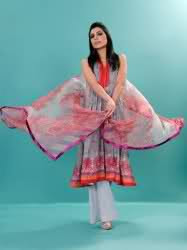Pakistani Fashion Clothes Definition
Source(google.com.pk)Traditional Indian suits, which are better known as salwar sets, are extremely popular among the Indian womenfolk, irrespective of age. This unique outfit defines versatility and blends it along with majestic appeal. This is the reason actually, why this dress has never gone out of the popularity chart in the last few centuries at a stretch. From the conventional point of standing, salwar suits used to come as three piece dress material, composed of the shirt alike - kurta, a pair of baggy lower tied with drawstring around the waist and a gorgeous dupatta.
The aspect of fashion is an ever evolving entity. With flow of time, these apparels have undergone a wide range of modification. A stunning array of fashionable salwar kameez have evolved and gained prominence in the present society. Salwar suits provide an excellent benefit for which, the dresses are widely appreciated. These are very helpful to wear in both domestic and professional work atmospheres. Fashion designers, as such, could not ignore the popularity of the apparel. It is mostly to the contribution of their creativity that salwar suits have emerged in the society with revamped shapes and designs.
Designer salwar kameez, command a stunning popularity among the customer segment. These outfits are available both as branded products, as well as local unbranded ones. From the aspect of fashion and comfort both the categories are at par with each other. Introduction of online shopping has further contributed to the commercial aspect of these apparels. There are many well reputed online stores that offer fabulous salwars at stunningly comfortable prices.
An elegant salwar suit is the most common wear in Indian weddings. However, a richly designed salwar requires supporting accessories. Choosing the right footwear is essential with any gorgeously designed salwar kameez. Some fashion divas even prefer to wear complimentary wristwatches and carry approving handbags along with them. In short, a salwar kameez, is the perfect getup for a all square fashion statement that can turn any number of heads on any given occasion. The Indian fashion industry is beaming with success these days, with salwar suits having considerable contribution behind it.
Traditional clothing in India greatly varies across different parts of the country and is influenced by local culture, geography, climate and rural/urban settings. Popular styles of dress include draped garments such as sari for women and dhoti or lungi or panche (in Kannada) for men. Stitched clothes are also popular such as churidar or salwar-kameez for women, with dupatta (long scarf) thrown over shoulder completing the outfit. Salwar is often loose fitting, while churidar is a tighter cut. For men, stitched versions include kurta-pyjama and European-style trousers and shirts for men. In urban centers, people can often be seen in jeans, trousers, shirts, suits, kurta and variety of other fashions.In public and religious places, Indian dress etiquette discourages exposure of skin and wearing transparent or tight clothes. Most Indian clothes are made from cotton which is ideal for the region's hot weather.Since India's weather is mostly hot and rainy, majority of Indians wear sandals.Indian women perfect their sense of charm and fashion with make up and ornaments. Bindi, mehendi, earrings, bangles and other jewelry are common. On special occasions, such as marriage ceremonies and festivals, women may wear cheerful colours with various ornaments made with gold, silver or other regional stones and gems.Bindi is often an essential part of a Hindu woman's make up. Worn on their forehead, some consider the bindi as an auspicious mark. Traditionally, the red bindi was worn only by married Hindu women, and colored bindi was worn by single women, but now all colours and glitter has become a part of women's fashion. Some women wear sindoor - a traditional red or orange-red powder (vermilion) in the parting of their hair (locally called mang). Sindoor is the traditional mark of a married woman for Hindus. Single Hindu women do not wear sindoor; neither do over 100 million Indian women from religions other than Hindu and agnostics/atheists who may be married.India's clothing styles have continuously evolved over the course of the country's history. The 11th-century BC Rig-veda mentions dyed and embroidered garments (known as paridhan and pesas respectively) and thus highlights the development of sophisticated garment manufacturing techniques during this period.[60] In 5th century BC, Greek historian Herodotus describes the richness of the quality of Indian cotton clothes. By the 2nd century AD, muslins manufactured in southern India were imported by the Roman Empire and silk cloth was one of the major exports of ancient India along with Indian spices. Stitched clothing in India was developed before the 10th century AD and was further popularized in the 15th century by Muslim empires in India. Draped clothing styles remained popular with India's Hindu population while the Muslims increasingly adopted tailored garments.During the British Raj, India's large clothing and handicrafts industry was left paralyzed so as to make place for British industrial cloth. Consequently, Indian independence movement leader Mahatma Gandhi successfully advocated for what he termed as khadi clothing — light colored hand-woven clothes — so as to decrease the reliance of the Indian people on British industrial goods. The 1980s were marked by a widespread modification to Indian clothing fashions which was characterized by a large-scale growth of fashion schools in India, increasing involvement of women in the fashion industry and changing Indian attitudes towards multiculturalism. These developments played a pivotal role in the fusion of Indian and Western clothing styles.
Pakistani Fashion Clothes
.jpg)
Pakistani Fashion Clothes
.jpg)
Pakistani Fashion Clothes
.jpg)
Pakistani Fashion Clothes
.jpg)
Pakistani Fashion Clothes
.jpg)
Pakistani Fashion Clothes
.jpg)
Pakistani Fashion Clothes

Pakistani Fashion Clothes

Pakistani Fashion Clothes

Pakistani Fashion Clothes

No comments:
Post a Comment